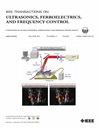确定具有基底约束的薄膜压电系数的分析和指南。
IF 3
2区 工程技术
Q1 ACOUSTICS
IEEE transactions on ultrasonics, ferroelectrics, and frequency control
Pub Date : 2024-09-12
DOI:10.1109/TUFFC.2024.3459593
引用次数: 0
摘要
压电薄膜(包括涂层)被广泛应用于各种机电设备中。压电薄膜特性的精确测量对于压电材料的开发和压电设备的设计都至关重要。然而,基底对压电薄膜变形的限制会对压电系数测量的可靠性和准确性产生重大影响。通过有限元理论分析和实验验证,我们确定了对测量结果影响较大的三个重要因素:基底与压电薄膜的杨氏模量比、电极尺寸与基底厚度比以及测试频率。我们的研究表明,基底与薄膜的杨氏模量之比相对较小,电极尺寸与基底厚度之比较大,会导致基底弯曲效应增大,从而可能产生更显著的测量误差。此外,过高的频率会激发强烈的横向位移波动,导致测量结果不可靠。我们比较了各种成熟的压电测量方法,并指出了常用压电薄膜和基底的突出测量问题。我们进一步确立了压电系数测量的准则,以实现高可靠性和准确性,这对于对机电活性材料和器件感兴趣的广大技术人员来说非常重要。本文章由计算机程序翻译,如有差异,请以英文原文为准。
Analysis and Guideline for Determining Piezoelectric Coefficient for Films With Substrate Constraint
Piezoelectric films including coatings are widely employed in various electromechanical devices. Precise measurement for piezoelectric film properties is crucial for both piezoelectric material development and design of the piezoelectric devices. However, substrate constraint on the deformation of piezoelectric films could cause significant impacts on the reliability and accuracy of the piezoelectric coefficient measurement. Through both theoretical finite element analysis (FEA) and experimental validation, here we have identified three important factors that strongly affect the measurement results: ratio of Young’s modulus of substrate to piezoelectric film, ratio of electrode size to substrate thickness, and test frequency. Our investigations show that a relatively smaller substrate’s Young’s modulus to film, and a larger ratio of electrode size to substrate thickness would cause a larger substrate bending effect and thus potentially more significant measurement errors. Moreover, intense transversal displacement fluctuation can be excited at excessively high frequencies, leading to unreliable measurements. Various well-established piezoelectric measurement methods are compared with outstanding measurement issues identified for those commonly used piezoelectric films and substrates. We further establish the guidelines for piezoelectric coefficient measurements to achieve high reliability and accuracy, thus important to the wide technical community with interests in electromechanical active materials and devices.
求助全文
通过发布文献求助,成功后即可免费获取论文全文。
去求助
来源期刊
CiteScore
7.70
自引率
16.70%
发文量
583
审稿时长
4.5 months
期刊介绍:
IEEE Transactions on Ultrasonics, Ferroelectrics and Frequency Control includes the theory, technology, materials, and applications relating to: (1) the generation, transmission, and detection of ultrasonic waves and related phenomena; (2) medical ultrasound, including hyperthermia, bioeffects, tissue characterization and imaging; (3) ferroelectric, piezoelectric, and piezomagnetic materials, including crystals, polycrystalline solids, films, polymers, and composites; (4) frequency control, timing and time distribution, including crystal oscillators and other means of classical frequency control, and atomic, molecular and laser frequency control standards. Areas of interest range from fundamental studies to the design and/or applications of devices and systems.

 求助内容:
求助内容: 应助结果提醒方式:
应助结果提醒方式:


